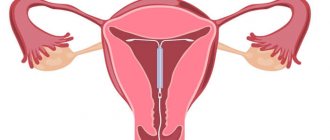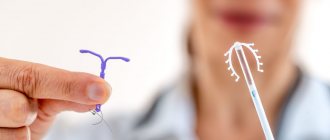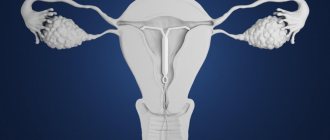An intrauterine device (IUD) is a method of contraception that involves inserting a special device into the uterine cavity to prevent fertilization of the egg and the attachment of the fertilized egg to the walls of the uterus.
IUDs are divided into two large groups: hormonal and non-hormonal. Non-hormonal ones can be made of polyethylene materials or copper, the latter may also contain silver or gold. Also, IUDs vary in shape, but most often they install “T”-shaped spirals, as they hold better. The installation of hormonal IUDs (for example, Mirena) may be prescribed both for contraception and for the treatment of certain diseases.
Dimensions of the IUD: length from 25 to 35 mm, thickness of the spiral itself from 1 to 2 mm.
Spirals are light in weight, from 100 to 150 mg.
The principle of operation of intrauterine devices.
Basically, the effect of the IUD is due to a mechanical obstacle to the passage of sperm.
In addition, under the influence of the hormonal IUD (Mirena), cervical mucus thickens and ovulation is suppressed. In some cases, fertilization still occurs, BUT in this case, the IUD prevents implantation.
The hormonal IUD can be used not only for contraception, but also for therapeutic purposes, for example, for endometriosis.
With the use of a hormonal IUD, menstruation becomes less abundant and may subsequently disappear completely. This is an expected reaction of the endometrium, and not a side effect. After the IUD is removed, the cycle is restored.
When is an IUD installed?
With a regular menstrual cycle, a copper-containing IUD is installed in the first 12 days after the start of menstrual bleeding, and a hormonal IUD in the first 7 days. In the case of a hormonal IUD, the contraceptive effect occurs 7 days after installation, so during these days it is necessary to use an additional method of contraception. After installing a copper-containing IUD, you can have open sex life from the moment of installation.
If the menstrual cycle is irregular, an IUD can be installed on any day, provided that the woman is definitely not pregnant! The IUD can be used during breastfeeding (4 or more weeks after birth).
Complications, side effects
The IUD does not cause the typical unpleasant symptoms caused by contraceptives. Women should not suffer from irritability, mood swings, water retention, weight gain or severe PMS symptoms. This is due to the fact that the IUD does not contain estrogen and does not cause hormonal disorders.
But, like any method of contraception, it has its drawbacks. These include:
- lack of protection against sexually transmitted diseases;
- cramps in the lower abdomen during menstruation;
- irregular menstruation (may even be absent);
- migraine.
How is an IUD installed?
Before installing an IUD, you must undergo the following examinations:
1. Ultrasound of the abdominal cavity and ultrasound of the breast
2. Tests for STIs
3. PAP TEST
The installation process itself takes about 20 minutes and takes place on the gynecological chair during the examination. The IUD is inserted into the uterine cavity, leaving control antennae in the vagina (for which the IUD is later removed). They will not cause you discomfort, BUT you need to be more careful when using tampons and removing them, since as a result of lightly tugging on the mustache, the spiral may shift and there will be no contraceptive effect.
The IUD can also be used by nulliparous girls, but there is a risk of the IUD falling out, since the uterus of nulliparous women is smaller.
Rules to follow
Remember, such contraceptives cannot be installed before the onset of the first menstruation, and also for mature ladies after 50 years.
Before the procedure, you should definitely take a smear for flora and infections, and cytology. Make sure that there is no pregnancy at the time of installation of the intrauterine device; to do this, it is enough to undergo an ultrasound examination of the pelvic organs; if in doubt, an additional hCG blood test.
Avoid sexually transmitted infections and use condoms when changing partners frequently. Understand that even ordinary pathogens behave extremely aggressively in the presence of the IUD and can provoke serious inflammation of the fallopian tubes and uterus.
The University Clinic offers a free consultation with a competent gynecologist online, an appointment with a specialist at a convenient time, a comprehensive examination, and a safe installation or replacement of an intrauterine device.
Advantages of contraception using the IUD.
- Long-term contraception: IUD is effective for 5 years
- Reliable method of contraception
- There is no need to monitor the regularity of taking pills, or the position of the patch or vaginal ring
- There are not as many side effects as when taking CHCs, including the IUD does not affect libido and does not increase the risk of thrombosis
- The hormonal IUD has a therapeutic effect in some gynecological pathologies (endometriosis, heavy menstruation, recurrent endometrial polyps)
- The IUD can be used during breastfeeding
- Quite an economical method of contraception
How it works?
The contraceptive device causes inflammation in the uterus, which makes fertilization impossible. The body begins to produce white blood cells that destroy sperm. Therefore, conception is impossible, pregnancy is impossible.
There are also hormone-releasing IUDs on the market that change the texture of cervical mucus, making it thicker, which is important for protection against pregnancy and infections. Therefore, the sperm loses its viability and moves more slowly.
The spirals are effective from the moment of “insertion” and remain fully effective for a long time, up to 5 years. Their advantage is that you can refuse them at any time and quickly return the body to its original state.
Disadvantages of using an intrauterine device.
- After installing the IUD, pain in the lower abdomen may persist for some time, 1-3 months. During this period, NSAIDs can be used.
- With a copper-containing IUD, menstruation may become more profuse, so much so that the IUD has to be removed.
- There is a risk of the spiral falling out or dislodging; this usually occurs within the first 3 months after installation. Therefore, if you feel that the IUD has fallen out or has shifted, consult a doctor immediately!
- Intermenstrual bleeding often appears, which causes inconvenience, but usually disappears in the first 2-3 months after installation.
- A common side effect during the first time after installation of a hormonal IUD is breast tenderness, headaches and slight weight gain.
- There are risks of pelvic inflammatory disease, so it is important to be screened for STIs before inserting an IUD. If you are concerned about persistent pain in the lower abdomen or pain during sexual intercourse, fever or abnormal discharge from the genital tract, then immediately contact your gynecologist.
- Although the IUD is a reliable method of contraception, BUT a low percentage of the probability of pregnancy still exists!
- It is extremely rare, but when installing an IUD, perforation of the uterus occurs - this is damage to the muscular layer of the uterus by the spiral! To avoid this situation, an OMT ultrasound and measurement of the length of the uterine cavity are performed before installation, and also after installation of the IUD, ultrasound control is necessary!
Rumyantseva, md.
Intrauterine contraceptives (spirals) are a method of long-term contraception (from 3 to 10 years, depending on the specific drug).
Two types of spiral:
- Cu-spirals are spirals coated with copper (today there are also spirals coated with silver and gold, but copper spirals are the most studied, so we will talk about them). Does not contain a hormonal component.
- LN-coils are coils containing a hormonal component (levonorgestrel).
Both spirals are installed by a doctor into the uterine cavity.
Operating principle of the intrauterine device:
- Copper-containing spirals (Cu-spirals) maintain aseptic inflammation in the uterus (inflammation without the participation of microorganisms), which reduces sperm motility and also disrupts the function of the endometrium (inner lining of the uterus), preventing the implantation of a fertilized egg. The rate of egg fertilization in women using a copper coil is lower than the average in the population.
- Levonorgestrel - containing spirals (LN - spirals) act on the principle of purely progestin contraceptives: the susceptibility of endometrial receptors to estrogen is reduced, and due to this, the endometrium does not “grow”, that is, conditions for implantation of a fertilized egg are not created. In addition, levonorgestrel-containing IUDs reduce sperm motility (the mechanism is similar to that of copper IUDs - creating an environment unfavorable for sperm in the uterine cavity), and in some women they inhibit ovulation.
Advantages of intrauterine devices:
- Both IUD options are highly effective (less than 1 pregnancy per 100 women during a year of use);
- The effect is reversible (most women may become pregnant in the first month after discontinuation);
- Does not require patient supervision;
- Does not require attention during sexual intercourse;
- It is possible to use the IUD in women of all ages (both those who have given birth and those who have not), however in Russia this method of contraception is traditionally recommended for women after childbirth;
- Can be used in nursing women (the drug passes into breast milk in low doses that are harmless to the baby; does not affect the quality and quantity of milk);
- No effect on libido;
- Non-contraceptive effect: treatment of heavy menstruation, reducing the severity of pain in endometriosis (LN - spiral), reducing the risk of endometrial cancer and cervical cancer;
- They do not increase the risk of developing breast cancer (in women who have had breast cancer, preference is still given to non-hormonal methods (Cu-coils)).
- They do not increase (or increase unreliably) the risk of developing venous thromboembolism and myocardial infarction.
Disadvantages of intrauterine devices:
- !The IUD does not protect against STIs! When choosing this method of contraception, it is necessary to use a condom when contacting a new/unregular/untested partner;
- Quite often, irregular (frequent, in some patients constant) spotting is observed (more than 60% of women in the first 3 months of use and up to 20% by the end of the first year of use). It is almost impossible to predict the appearance of these secretions or get rid of them if they appear (you have to remove the coil);
- By the end of the first year of using the IUD (in particular, the LN IUD), half of the patients experience amenorrhea (complete absence of menstruation), which is not harmful to health, but is psychologically uncomfortable for many patients;
- In the first 20 days after installation of the IUD, the likelihood of developing an ascending infection and inflammation of the pelvic organs increases. Usually it is possible to cope with the problem with the use of antibiotics, but sometimes it is necessary to remove the coil;
- Possible side effects of LN - spirals: increased acne, increased sensitivity/pain in the mammary glands, headaches, weight gain (in total, more than 10% of women will experience certain side effects).
Possible complications when using intrauterine devices:
- “Losing out” of the IUD (approximately every 20th woman) occurs most often in the first 3 months after insertion.
- Formation of ovarian cysts when using the LN-spiral. In most cases, these cysts are asymptomatic and disappear without treatment.
- Perforation (damage, including the full thickness) of the uterine wall (in approximately 2 cases per 1000 insertions of the IUD).
- There may be an increase in the frequency of relapses of bacterial vaginosis and vulvovaginal candidiasis (Cu - spirals).
Contraindications to the use of intrauterine devices:
Spirals (both with and without a hormonal component) should not be used in the following cases:
- Pregnancy;
- Postpartum period (2 months) – if the IUD is not installed immediately after childbirth;
- Postpartum sepsis;
- Termination of pregnancy accompanied by infectious complications (until the complications are cured);
- Vaginal bleeding of unknown origin;
- Trophoblastic disease;
- Cervical cancer before treatment;
- Endometrial cancer;
- Inflammatory diseases of the pelvic organs;
- Sexually transmitted infections: chlamydia, gonorrhea (the IUD cannot be inserted, but there is no need to remove it);
- Tuberculosis with damage to the pelvic organs;
- Breast cancer (for LN - spirals).
It is not advisable to install an IUD if the patient is taking therapy for HIV. If the coil is already installed, there is no need to remove it.
Examinations required before inserting the spiral
- Examination on the chair;
- Test for STIs (if not previously examined or after a change of partner);
- PAP test (if not passed as part of a medical examination earlier (within a year)).
!There is no need to cauterize the “erosion” before placing the uterine device (if we are talking about ectopia, of course. You can read more about the difference between erosion and ectopia here).
If you have any acute or chronic disease at the time of installation of the IUD, discuss the possibility and advisability of using this method of contraception with your doctor.
Start of application: Cu-spirals
The main rule when placing a Cu coil is to be sure that the woman is not pregnant. If pregnancy is excluded, the IUD can be placed on any day of the cycle. Moreover, the IUD can be installed within 5 days after unprotected sexual intercourse as a method of emergency contraception (with a transition to long-term planned contraception, of course).
Cu coils can be inserted immediately after an abortion or natural birth without complications (there is no need to wait 6 weeks after birth). After birth by caesarean section, installation of a Cu coil is possible after 8-12 weeks.
When switching from one method of contraception to another, the IUD can be installed immediately after the end of the use of previous contraceptives (there is no need to take a break for a month).
There is no need to use additional methods of contraception after installing the IUD (except for protection against STIs).
Start of application: LN – spirals
The LN spiral can be placed on any day of the cycle.
LN-spirals can be installed immediately after an abortion or natural birth without complications (there is no need to wait 6 weeks after birth). After birth by cesarean section, installation of an LN-spiral is possible no earlier than 6 weeks later.
When switching from one method of contraception to another, the IUD can be installed immediately after the end of the use of previous contraceptives (there is no need to take a break for a month).
If the IUD is installed less than 7 days after the start of menstruation, there is no need to use additional contraception. If the IUD is installed 7 days or more after the start of menstruation, it is necessary to use additional methods of contraception (condom) for 7 days after insertion of the IUD.
If the IUD is installed immediately after childbirth/abortion, there is no need to use additional contraceptives; in other cases, 7 days of using additional barrier methods.
!If a woman used another method of contraception (pills, for example) before inserting the IUD, she can continue using the drugs for the required 7 days after inserting the IUD, rather than switching to using a condom.
Monitoring and management of patients after installation of the spiral
- After installation of the IUD, there is no need for prophylactic use of antibiotics.
- Some manufacturers recommend a follow-up examination 4-12 weeks after installation of the coil. During the examination, the doctor will make sure that the device is in the uterine cavity, and the patient will also have the opportunity to discuss with the doctor the possible side effects of the contraceptive method used.
- Women do not need additional visits to the gynecologist (besides routine annual examinations) after installation of the IUD.
- If any side effects occur that the doctor did not warn about during installation of the IUD, you should consult a gynecologist.
Be sure to consult a doctor if you notice the following symptoms:
- sharp pain in the lower abdomen,
- heavy bleeding from the vagina,
- change in the nature of vaginal discharge,
- rise in body temperature.
Change in the nature of menstrual flow after installation of the IUD
Quite often, after installation of the IUD, irregular menstrual-like bleeding or spotting, as well as heavier and/or longer periods, are observed.
Irregular bleeding is observed in 67% of women in the early stages of use, by the end of the first year - in approximately 20% of women. Rare bleeding occurs in 11% of patients during the first 90 days of use. By the end of the first year, a complete absence of menstruation is observed in approximately 20% of women, and rare menstruation is observed in 57%. Some women may maintain regular menstruation, but their abundance and duration can vary significantly (both downward and upward)
Most often, these effects disappear 3-6 months after installation of the spiral. In some situations, incessant spotting becomes a reason to remove the IUD and select a different method of contraception.
What to do if pregnancy occurs after installation of the IUD?
This event is quite unlikely, but still occurs occasionally in clinical practice.
First of all, you need to make sure that the pregnancy is in the uterus (to do this, take a blood test for B-hCG several times over time and monitor the appearance of the fertilized egg in the uterus using ultrasound).
If a woman does not want to continue the pregnancy, there are several options for terminating it (almost always there is a need to remove the IUD to terminate the pregnancy).
If a woman wants to continue her pregnancy, it is worth considering that in this case the risk of miscarriage and premature birth is significantly increased. Therefore, if possible, it makes sense to remove the IUD, despite the fact that this procedure itself can lead to termination of pregnancy (less likely than the likelihood of miscarriage/premature birth if the IUD is left in place).
Removing the spiral
The IUD is removed by a gynecologist during menstruation. This procedure is virtually painless and takes a couple of minutes. If, during the use of the IUD, severe illnesses/complications arise that require removal of the IUD, it can be performed on any day of the cycle, however, outside of menstruation, the procedure can be more technically complex and painful.
Sources:
- https://www.acog.org/Resources-And-Publications/Practice-Bulletins/Committee-on-Practice-Bulletins-Gynecology/Long-Acting-Reversible-Contraception-Implants-and-Intrauterine-Devices
- https://www.fsrh.org/standards-and-guidance/documents/ceuguidanceintrauterinecontraception/
- https://www.cdc.gov/mmwr/volumes/65/rr/pdfs/rr6504.pdf
Similar
Facebook comments
Contraindications to the installation of an IUD.
- Presence of a sexually transmitted infection
- Inflammatory processes of the pelvic organs (including in the postpartum period and the period after termination of pregnancy)
- Cervical cancer, uterine cancer, breast cancer
- Anomalies of the uterus - bicornuate uterus, septum in the uterine cavity
- Submucous uterine fibroids
- Uterine bleeding of unknown etiology
- Pregnancy
- Allergy to copper, Wilson-Konovalov disease - in the case of copper-containing IUDs
- Liver diseases and tumors, hypersensitivity to levonorgestrel - in the case of a hormonal IUD
Author: obstetrician-gynecologist Tarakanova M.Yu.
Indications for use and benefits
The Mirena system can be used in the following cases:
- for the treatment of abnormal menstrual bleeding;
- to protect against unplanned pregnancy;
- treatment of female diseases such as adenomyosis, endometriosis, uterine fibroids.
The main advantages of its use include:
- an effective and reliable method of contraception;
- ease of use, lack of discomfort;
- does not have systemic hormonal effects;
- reduces blood loss during menstruation;
- reduces the likelihood of inflammatory pelvic diseases;
- insertion and removal of the coil does not cause pain or discomfort.
In terms of effectiveness, the use of this type of contraception can be compared to sterilization. Much more effective than other methods of protection against unplanned pregnancy (pills, condoms). There is only 1 case of unwanted pregnancy per thousand women. Women who experience excessive blood loss during menstruation cease to suffer, and the amount of discharge noticeably decreases after a couple of months. Some girls may not have periods at all.









